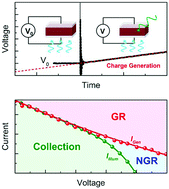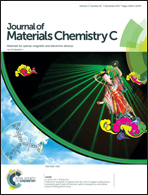Photovoltage as a quantitative probe of carrier generation and recombination in organic photovoltaic cells†
Abstract
Photoconversion in organic photovoltaic cells (OPVs) is limited by carrier recombination that frustrates charge collection at the electrodes. Consequently, identification of the dominant recombination mechanisms is critical to inform device design for improved performance. This analysis is complicated by the need to have a quantitative measure of carrier generation. Here, we demonstrate a photovoltage-based technique to directly investigate the generation of charge carriers in OPVs. This technique allows illuminated current losses to both geminate and non-geminate recombination to be directly quantified as a function of voltage. While broadly applicable, here the technique is demonstrated on OPVs based on the donor–acceptor pairings of 2-((7-(4-N,N-ditolylaminophenylen-1-yl)benzo[c][1,2,5]thiadiazol-4-yl)methylene)malononitrile (DTDCPB)-C60 and copper phthalocyanine (CuPc)-C60. Both structures are limited by geminate recombination at short-circuit and under reverse bias. Under forward bias, the severity of non-geminate recombination depends on both materials selection and device architecture. Consequently, this technique quantitatively casts changes in performance with choice of OPV architecture in terms of the relative roles of geminate and non-geminate recombination.



 Please wait while we load your content...
Please wait while we load your content...